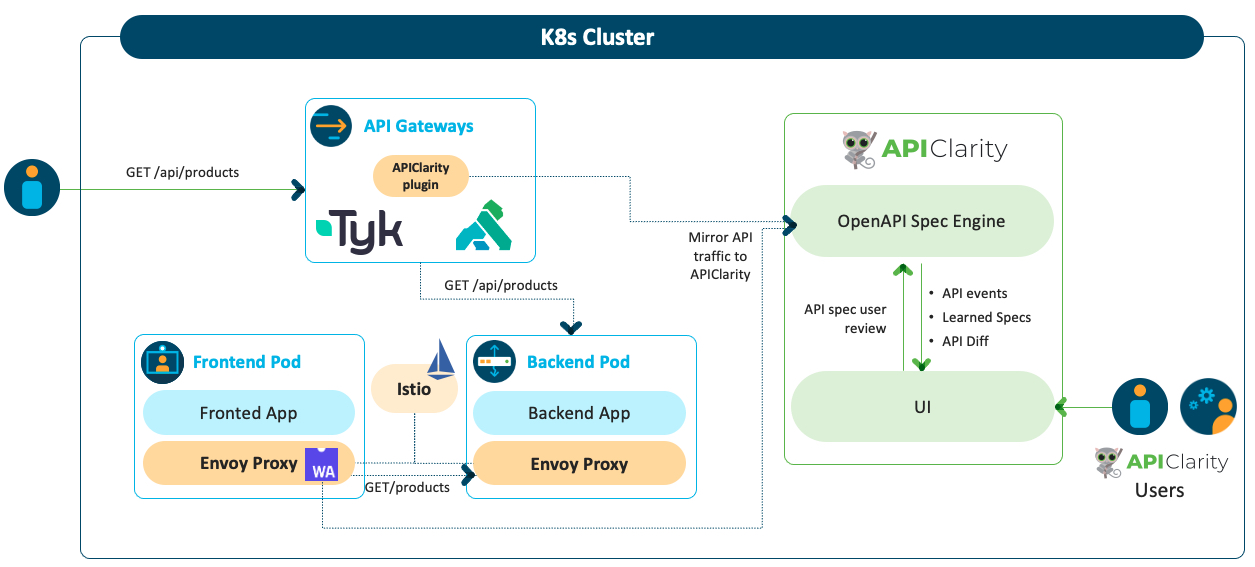Reconstruct OpenAPI Specifications from real-time workload traffic seamlessly.
- Not all applications have an OpenAPI specification available
- How can we get this for legacy or external applications?
- Detect whether microservices still use deprecated APIs (a.k.a. Zombie APIs)
- Detect whether microservices use undocumented APIs (a.k.a. Shadow APIs)
- Generate OpenAPI specifications without code instrumentation or modifying existing workloads (seamless documentation)
- Capture all API traffic in an existing environment using a service mesh framework (e.g. Istio)
- Construct an OpenAPI specification by observing API traffic or upload a reference OpenAPI spec
- Review, modify and approve automatically generated OpenAPI specs
- Alert on any differences between the approved API specification and the API calls observed at runtime; detects shadow & zombie APIs
- UI dashboard to audit and monitor the findings
APIClarity supports integrating with the following taffic sources. Install APIClarity and follow the instructions per required integration.
-
Istio Service Mesh
- Make sure that Istio 1.10+ is installed and running in your cluster. See the Official installation instructions for more information.
-
Kong API Gateway
-
Tyk API Gateway
-
Add Helm repo
helm repo add apiclarity https://apiclarity.github.io/apiclarity
-
Deploy APIClarity with Helm
helm install --set 'global.namespaces={namespace1,namespace2}' --create-namespace apiclarity apiclarity/apiclarity -n apiclarity
Note: Helm configures the monitored namespaces only for Istio intergation. namespace1 and namespace2 are the namespaces where the Envoy Wasm filters will be deployed to allow traffic tracing. Leave the namespaces list empty when Istio integration is not needed.
-
Port forward to APIClarity UI:
kubectl port-forward -n apiclarity svc/apiclarity-apiclarity 9999:8080
-
Open APIClarity UI in the browser: http://localhost:9999/
-
Generate some traffic in the traced applications and check the APIClarity UI :)
The file values.yaml is used to deploy and configure APIClarity on your cluster via Helm. This ConfigMap is used to define the list of headers to ignore when reconstructing the spec.
A good demo application to try APIClarity with is the Sock Shop Demo.
To deploy the Sock Shop Demo follow these steps:
-
Create the
sock-shopnamespace and enable Istio injection:kubectl create namespace sock-shop kubectl label namespaces sock-shop istio-injection=enabled
-
Deploy the Sock Shop Demo to your cluster:
kubectl apply -f https://raw.githubusercontent.com/microservices-demo/microservices-demo/master/deploy/kubernetes/complete-demo.yaml
-
Deploy APIClarity in the
sock-shopnamespace:helm install --set 'global.namespaces={sock-shop}' apiclarity apiclarity/apiclarity -n apiclarity -
Find the NodePort to access the Sock Shop Demo App
$ kubectl describe svc front-end -n sock-shop [...] NodePort: <unset> 30001/TCP [...]
Use this port together with your node IP to access the demo webshop and run some transactions to generate data to review on the APIClarity dashboard.
Build and push the image to your repo:
DOCKER_IMAGE=<your docker registry>/apiclarity/apiclarity DOCKER_TAG=<your tag> make push-dockerUpdate values.yaml accordingly.
-
Build UI & backend locally as described above:
make ui && make backend -
Copy the built site:
cp -r ./ui/build ./site
-
Run backend and frontend locally using demo data:
DATABASE_DRIVER=LOCAL FAKE_TRACES=true FAKE_TRACES_PATH=./backend/pkg/test/trace_files \ ENABLE_DB_INFO_LOGS=true ./backend/bin/backend run
-
Open APIClarity UI in the browser: http://localhost:8080/
Pull requests and bug reports are welcome.
For larger changes please create an Issue in GitHub first to discuss your proposed changes and possible implications.
